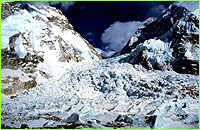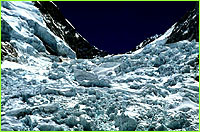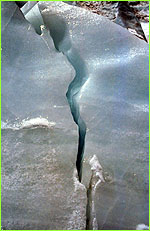
|
 |
 |
 The Anatomy of a Glacier
The Anatomy of a Glacierby Jean Monahan Photography by Liesl Clark "We're standing on the Khumbu Glacier right now and although it looks a rather static sight and quite beautiful with blue pinnacles and a deep blue sky with the moon popping up in the middle of it, it's just white and blue we can see all around us. It looks absolutely static but it isn't. Occasionally there's a pop, a groan, a creak, as this glacier relentlessly moves downhill. Millions and millions of tons of ice are slowly moving. If we could speed it up we could actually see something like a river coming down from above us with the Khumbu Icefall sliding around the corner here and heading south toward the Ganges Plain in India. The ice south of us is tens of thousands of years old and the ice to the north, above us, is even older."—Roger Bilham  Icefalls
IcefallsOn Mount Everest, glaciers have created a harrowing stretch of ice known as the Khumbu Icefall, which confronts mountaineers at the very start of their climb. An icefall is created when a glacier begins to move downhill on a steep slope. Icefalls are literally hanging glaciers, falling slowly over geological time by the force of gravity. As glaciers advance down mountainsides and into valleys, they break apart and accumulate into massive piles of melting and solid ice with huge gaps separating ice blocks the size of houses. The ice blocks then continue to tilt and twist under the weight of the ice above them.  Continue
ContinueLost on Everest | High Exposure | Climb | History & Culture | Earth, Wind, & Ice E-mail | Previous Expeditions | Resources | Site Map | Everest Home Editor's Picks | Previous Sites | Join Us/E-mail | TV/Web Schedule About NOVA | Teachers | Site Map | Shop | Jobs | Search | To print PBS Online | NOVA Online | WGBH © | Updated November 2000 |